|
|

|
|
Author
|
Topic: Space Cover 508: '...before the big one!'
|
stevedd841
Member Posts: 299
From: Millersville, Maryland
Registered: Jul 2004
|
 posted 03-31-2019 01:29 PM
posted 03-31-2019 01:29 PM
   
Space Cover of the Week, Week 508 (March 31, 2019)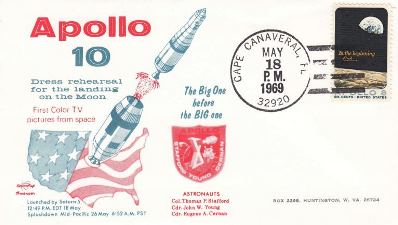 Space Cover #508: The Big One Before The Big One!Carl Swanson, space cover cachet maker, coined the phrase "The Big One Before the Big One" on a space cover he designed for the Apollo 10 mission and his anticipation that if the Apollo 10 mission succeded, then the next mission for Apollo 11 assuredly would be the mission that would land astronauts Neil Armstrong and Buzz Aldrin on the Moon. 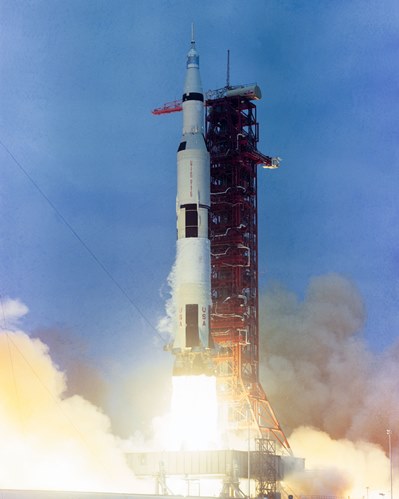 The Apollo 10 crew of Lunar Module Pilot Gene Cernan, Apollo 10 Commander Tom Stafford, and CSM Pilot John Young start their space journey to the Moon. As four and a half g's push the Apollo 10 crew members back into their canvas couches, Gene Cernan yells, "What a ride!" as Apollo 10 thunders into space. Gene Cernan comments, "We accelerated with breathtaking speed," as the second stage of the Saturn V rocket fires for seven minutes. He further notes, "Things happened so fast on a Saturn." Apollo 10 speeds into Earth orbit at 116 miles altitude and is already approaching the coast of Africa. After an orbit and a half, over Sydney, Australia, Flight gives the crew a "go" for their TLI burn to speed Apollo 10 on its way to the Moon. Tom Stafford, still with his hand on the abort handle, remarks in a staccato fashion, "Ok, we're getting a little bit of high frequency vibrations here in the cabin. Nothing to worry about." And pushing the words out a syllable at a time between firmly set, clenched teeth because of the severe vibration the crew is experiencing." Gene Cernan observes, "We burst through to 20,000 miles per hour, and finally up to 24,300," as Apollo 10 creaked and groaned on its way like an old house in winter.  Above is a crew signed Orbit cover signed by commander, Tom Stafford; CSM pilot, John Young; and lunar module pilot Gene Cernan is shown for the launch date of Apollo 10, May 18, 1969, at Cape Canaveral, Florida. The crew's launch in Apollo 10 is both violent and shocking for crew members Stafford, Young, and Cernan who think the flight may have to be aborted if the rocket booster should fail structurally during launch. Gene Cernan continues, "We guessed right. The third stage shut down right on schedule, the bouncing stopped and silence reigned as we slid into a freecoast to the Moon. I was pleased and relieved, to find myself still in one piece. Wernher's people had built a hell of a machine." Tom slowly released the handle and his familiar Oklahoma drawl drifted down to Houston, "We're on our way." As the rocket booster shuts down on time, Stafford lets go of the abort handle, and the crew breathes a sigh of relief. Apollo Control confirms Apollo 10 is on course and tracking properly on its trajectory to the Moon. Gene Cernan describes what he sees, "As we slowly rotated, the Earth came into view for the first time on the mission, and it was a unique, jarring sight. Our cloud wrapped blue globe was surrounded by a blackness of such great depth that for the first time, I realized that I was truly on a space voyage." On schedule, John Young maneuvers the Charlie Brown CSM deftly and hits the bulls-eye as the Saturn pod and the Apollo 10 spacecraft close one another. Young remarks, "Snap, snap, and snap, and we're there," as the two spacecraft latch together. Young then reverses thrust of the Apollo 10 and pulls spacecraft Snoopy free from the Saturn pod. On the third day of the mission, Apollo 10 outruns Earth's gravitational pull and is now slowly but inexorably drawn by the Moon's gravity as Gene Cernan says, "...like a leaf in a whirlpool." If the crew missed on the timing to put on the brakes at this point, they would become yet another crater on the Moon. Tom Stafford gives the command to execute their burn and Apollo 10 is suddenly in lunar orbit in darkness and on the backside of the Moon. John Young was alone now in the command module, having started Apollo 10's separation procedure on the far side of the Moon. There was a quiet thud as the docking latches snapped open, and John carefully backed away the command module from Snoopy. Gene remarks 'It was an exciting moment, John now was our only ticket home. Tom and I fired Snoopy's small thrusters to gain more distance for us and to adjust our position." Without thick insulation around us, every firing of a Snoopy jet sounded like someone beating on a garbage can with a hammer." John grabbed the television camera on the command module and gave viewers on Earth great pictures of Snoopy's tin sides glistening in the sunlight with its spidery legs stretched out, comfortable in its home environment above the Moon's backdrop and the lunar surface. Ready to start their descent above the Moon's surface, the crew fires the descent stage rocket of the lunar lander, and Cernan further says, "Down we swooped, lower and lower, and the Moon ceased being a big gray ball, flattened out, and gave us a horizon. It now almost looked as if we were flying over an Arizona desert, but no desert has ever had such terrain. Those crater walls we had once looked down into now took on had the distinct and menacing look of an onrushing mountain range, for it seemed like we were below their peaks. Fields of boulders grew in size and shadows lengthened below canyon walls that grew on both sides, their flat tops appearing to be high above our little flying bug. The firing of the descent stage rocket only lasted fifty nine seconds as Snoopy passed over the southwest corner of the Moon's Sea of Tranquility. Cernan is ecstatic, and says, "Down there! The landing site!" Ready to shift now to the ascent stage to rejoin Young orbiting overhead, all hell breaks loose as Stafford yells, "Gimbal lock!" as the lunar module spins out of control at 3,000 miles per hour and now only 47,000 feet above the surface of the Moon. Tom Stafford yells to the CapCom in Mission Control, "We're in trouble! as the lander does cartwheels over the Moon's surface with its computer navigation system and AGS suddenly not working. Stafford quickly moves to override the computer and takes manual control of the spacecraft. And it was a very long fifteen seconds for Stafford to fix the sudden lunar lander problem.  Later analysis by NASA engineers would show that the crew would have spun into the lunar surface and crashed if this had continued for another two seconds. 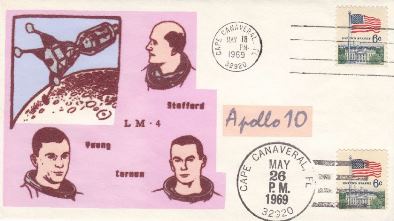 Cernan recovers, and notes, "Things had been more than a little tense. Hell, I was scared to death. We got back on track immediately," Stafford reporting to CapCom in Houston added, "We've got all our marbles." Their lunar module fires and Stafford and Cernan in Snoopy speed back into lunar orbit at a fantastic clip. Cernan coolly adds, "Baby, let's make this one. We're burning!" The Apollo 10 crew called it, "the gamble." After thirty-one lunar orbits, they knew that on the last orbit they would have to depend on the service propulsion system to work on command to rocket them out of lunar orbit on the TEI trajectory back to Earth. And this SPS operational test had only been done once before. If the SPS misfired, fired late, or did not fire at all, the crew also knew, "...the game was over." Apollo 10 is seen as a brilliant shooting star streaking across the South Pacific as it reenters Earth's atmosphere. Day breaks and the soft pastel colors of dawn welcome the crew back. The crew comes back to Earth burning-off extra fuel and accelerating to a smoking 25,000 plus miles per hour, but the reentry window was small, specifically only plus or minus half a degree for the spacecraft's angle of entry. This is like a golfer teeing off from the Moon's Sea of Tranquility and making a hole-in-one golf shot in Pebble Beach, Monterey, California. And, remember, you only have one shot to make it. Apollo 10 is home!. 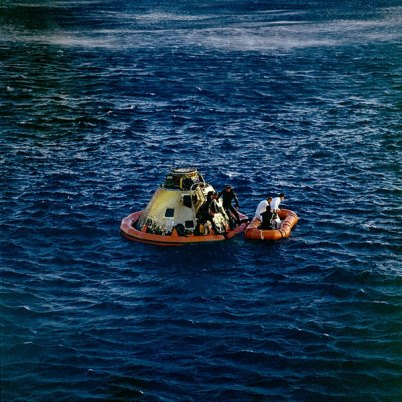 Successful completion of Apollo 10's mission and recovery sets the stage for the next space mission for Apollo 11, whose astronauts will land on the Moon. As Apollo 10 was being recovered in the South Pacific, Apollo 11 was already being stacked at Launch Complex-39, pad B, at Cape Canaveral, Florida, for its July flight.  This crew signed cover for completion of the Apollo 10 mission is not the best example of the Beck rubber-stamped cachet cover for the USS Princeton recovery of the Apollo 10 crew after their splashdown in the South Pacific Ocean near Samoa. However, this cachet is more than offset by the Princeton's recovery cover being signed by Apollo 10 commander, Tom Stafford; command service module pilot, John Young; and lunar module pilot, Gene Cernan; on the crew's recovery date, May 18, 1969. The helo pilot has painted, "Hello, 'der, Charlie Brown!" on the bottom of the recovery helo for the Apollo 10 crew to see upon their recovery. The Apollo 10 crew signed cover for their mission is one of the most difficult Apollo crew signed space covers to find. If you should see one in your searches, don't pass it up! Steve Durst, Space Unit 4379 |
Bob M
Member Posts: 1866
From: Atlanta-area, GA USA
Registered: Aug 2000
|
 posted 04-05-2019 02:56 PM
posted 04-05-2019 02:56 PM
   
Very well-done and interesting presentation, Steve, along with some special covers. It was interesting to read again about the Apollo 10 mission, including some things I had forgotten - such as the loss of control of the LM caused them to come within 2 seconds of them impacting the moon! Two more seconds and surely Apollo 11 wouldn't have been the first moonlanding and it may not have even happened at all! |
cvrlvr99
Member Posts: 205
From: Arlington, TX
Registered: Aug 2014
|
 posted 04-06-2019 12:40 PM
posted 04-06-2019 12:40 PM
   
Shown here are my two favorite covers for the Apollo 10 flight. The KSC official launch cover is signed by the crew, but John Young actually added the text, "To Ray, Best wishes." It was hard enough to get his signature, much less personalized. The cancels on the PRS were all done as machine cancels, insofar as I have been able to determine. But when I saw a hand cancel, and to the right, a partial machine cancel I bought it immediately, later adding signatures of Cernan and Stafford to make it a little more unique. Does anyone else have one with a machine cancel? 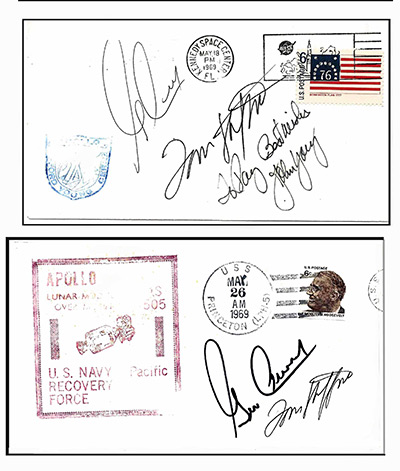 |
micropooz
Member Posts: 1706
From: Washington, DC, USA
Registered: Apr 2003
|
 posted 04-07-2019 07:09 AM
posted 04-07-2019 07:09 AM
   
Below is my Apollo 10 USS Princeton hand cancel. I got this many years ago from Steve Durst. I'll bet he’s sitting on an even nicer one...And speaking of many years ago, Apollo 10 was used as an example for an introduction to prime recovery ship collecting in SCOTW 6.  |
ea757grrl
Member Posts: 798
From: South Carolina
Registered: Jul 2006
|
 posted 04-07-2019 10:23 AM
posted 04-07-2019 10:23 AM
   
I checked my collection and my Apollo 10 recovery cover has a very good machine-cancel and a mostly-complete purple Beck rubber-stamped cachet, reasonably centered on the left-hand side.As an aside, the Carl Swanson cover in the thread starter includes the caption "Dress rehearsal for the landing on the moon." Coincidentally, the CBS News coverage of Apollo 10 used the phrase "Dress rehearsal for a landing on the Moon" as a subtitle. |
Ken Havekotte
Member Posts: 3669
From: Merritt Island, Florida, Brevard
Registered: Mar 2001
|
 posted 04-07-2019 01:53 PM
posted 04-07-2019 01:53 PM
   
Yes, indeed, the flight of Apollo 10 was one of most exciting Apollo flights from start to finish, as Steve has reported on. It had been the first launch from Pad "B" at Launch Complex 39, and going forward nearly 17 years later, it was used for a second time in January 1986 when Challenger and her crew of seven were lost.When Gene Cernan said, "What a ride, babe, what a ride!" it had reminded me of when the same-type phrase was uttered by Alan Shepard 8 years earlier, "Boy what a ride!" when he was flown from Freedom 7 to the aircraft carrier Lake Champlain 4 miles away after becoming the first American into space. On a personal note, as a first year teenager, the Apollo 10 flight had been very special to me. My family had just moved from Illinois to Florida only a few short months earlier after Dad left the Air Force after a long military career. We had just settled into a new home on Merritt Island when I heard there would be a "Welcome Home" motorcade parade and dinner for the Apollo 10 crewmen in coming back to the Florida Space Coast on June 11, 1969, in Cocoa Beach and earlier at the Kennedy Space Center. When hearing about the Apollo 10 festivities, of course, I wanted to go and see the hero-astronauts that have just returned from orbiting the moon. My Mom
wanted to see them to, but my Dad, brother and twin sister had no interest in seeing them. So my Mom drove me over to Cocoa Beach that afternoon, and boy, was it a circus out there with so many thousands of onlookers everywhere all lined up and down the parade route, and needless to say, the traffic was horrendous. As the crew rode by, it was a first time for me in seeing a "live" astronaut, but not just one, but a whole trio of moon voyagers! I cheered, waved, and thought for sure each of the crewmen looked right back at "me" and waved (well, after all, I was only a kid and really wanted to believe that each of them did). Well, going forward a few decades, I was fortunate to have Gen. Stafford in my home on a few occasions. Looking back, though, never did it ever cross my mind that I would someday have the veteran Gemini and Apollo astronaut commander in my home for a personal visit(s), along with other astronaut pioneers of the Gemini, Apollo, Skylab, ASTP, and Shuttle programs. It was a dream come true, almost an impossible dream back in that era, and I often think back to that exciting summer day in 1969 as a special time for me and my Mom being together. We lost her in 2003, but my Mother had always been an encouragement and inspiration in helping me pave my own space road. Below are a few highlight pieces from my own Apollo 10 philatelic and memorabilia collections. I do have a crew signed Apollo 10 VIP launch card, however, I am still trying to locate the card. Also, to answer Ray's question, below is a machine cancelled Navy RSC crew signed cover. I've got a few more mission items signed, flown objects, badges, individual crewmen autographs, many types of official patches, vintage-era acrylics, Betas, photos, literature, and hundreds more of Apollo 10 postal covers. Two of the cachet covers were signed in crew quarters before their lunar-bound spaceflight, but not too well known by most space cover collectors, is that one of those Apollo 10 cachet covers by Heritage Crafts was in fact used by the crewmen for their own personal purposes. Well, the Big one before the BIG one, was in some ways Apollo 10 for me! I can still remember the excitement and thrill of seeing my first astronauts in-person that had just returned from another world! 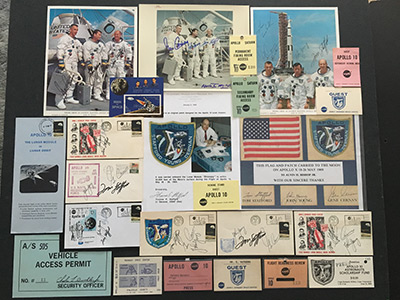 |
stevedd841
Member Posts: 299
From: Millersville, Maryland
Registered: Jul 2004
|
 posted 04-08-2019 12:02 PM
posted 04-08-2019 12:02 PM
   
quote:
Originally posted by cvrlvr99:
Shown here are my two favorite covers for the Apollo 10 flight.
Ray, you present a great crew signed cover for the Apollo 10 mission. For many of us who watched the launch of this mission and the various challenges they were presented with during the mission, including gimbal loss of the LM 50,000 feet above the Moon, it was stunning that Stafford and Cernan were able to recover their lunar mission, avoid crash landing on the Moon, and turn their remarkable mission into an incredible success. Many thanks for showcasing your Apollo 10 covers to us! quote:
Originally posted by Ken Havekotte:
Well, the Big one before the BIG one, was in some ways Apollo 10 for me!
That was pretty much the way I felt as well watching how this mission unfolded. Many, many thanks for showcasing some of the other incredible Apollo 10 covers you have as well as covers from the VIP visitor's area, a major achievement for those of us who spend a lot of time looking at Apollo mission covers. Many, many thanks for helping me highlight the remarkable Apollo 10 crew's mission and their showing the way later for the Apollo 11 crew's mission. |
stevedd841
Member Posts: 299
From: Millersville, Maryland
Registered: Jul 2004
|
 posted 04-08-2019 01:17 PM
posted 04-08-2019 01:17 PM
   
quote:
Originally posted by ea757grrl:
...the CBS News coverage of Apollo 10 used the phrase "Dress rehearsal for a landing on the Moon" as a subtitle.
You noted exactly what I did when I was looking at Apollo 10 covers in my collection that could be openers for my review of the Apollo 10 lunar mission on Space Cover of the Week. At the last minute, I changed my mind to think it would be better to focus on the comment in Carl Swanson's Space Craft Cover statement, 'The Big One Before The Big One' with some heavy thinking, "What does that mean?" One additional reader added a similar comment to me afterwards affirming that had Apollo 10 crash landed into the lunar surface not far from the Sea of Tranquility where Apollo 11 was planned to land on the Moon, the Apollo 10 crew would have been killed, and I am fairly certain that the next mission, Apollo 11, would have been cancelled and possibly the remaining Apollo lunar missions would have been cancelled as well. That would have been stunning and very sobering. But, as fate would have it, that did not happen. Many thanks for your response back to me for my Space Cover of the Week for Apollo 10. |
Ken Havekotte
Member Posts: 3669
From: Merritt Island, Florida, Brevard
Registered: Mar 2001
|
 posted 04-09-2019 06:56 AM
posted 04-09-2019 06:56 AM
   
Hard to say for sure, Steve, but if Stafford and Cernan did not return back from the moon in crashing their LM-Snoopy, the Apollo program might still have continued for another lunar orbital attempt.It would all depend on the results of the post-mission investigative report and findings as to why the LM aspect of the mission failed. With nearly $24 billion already invested within a decade in NASA's manned spaceflight programs and with over 400,000 people working in the space industry at the time, a repeat Apollo 10-type orbital flight might had still been a possibility, in my opinion. But of course, whatever the main issue had been causing a LM failure and lost of crew, it must be completely understood, fixable, and repaired so that a same-similar concern could/would not happen again. If such challenges could not be completely corrected/understood, maybe under those severe conditions would Apollo not fly again. | |
Contact Us | The Source for Space History & Artifacts
Copyright 2023 collectSPACE.com All rights reserved.

Ultimate Bulletin Board 5.47a
|
|

|
 advertisement advertisement

|





















